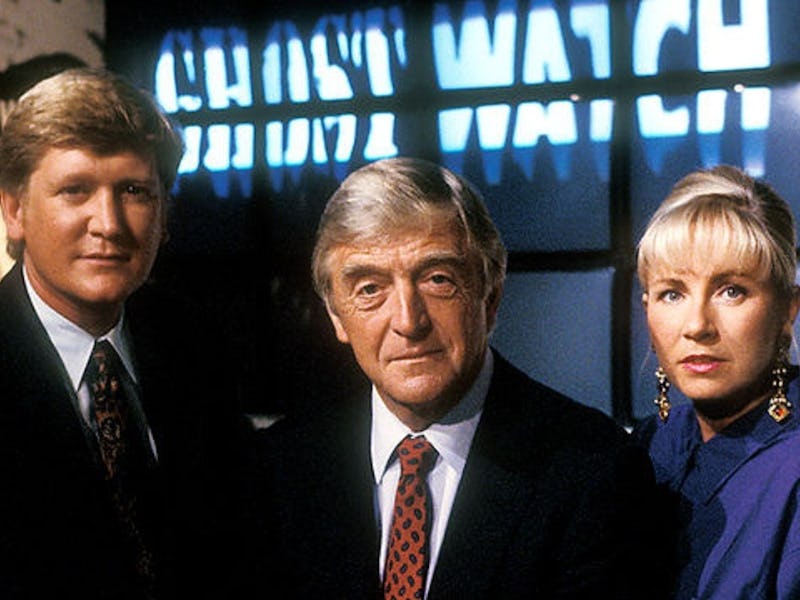'Ghostwatch': The Most Effective Mockumentary Horror You've Never Seen
A show that resulted in 30,000 calls to the BBC is worth watching.

“The program you’re about to watch is a unique live investigation of the supernatural,” says Ghostwatch host Michael Parkinson during the show’s opening moments. In the early nineties, British viewers accepted this introduction as fact, allowing the reliable, trustworthy BBC the chance to terrify a nation with a mockumentary horror to the likes of which had never been seen before.
First broadcast on Halloween night 1992 the show positions itself as a real-life haunted house investigation, cutting between studio presenters — Parkinson and Mike Smith — to on-the-ground reporters — Sarah Greene and Craig Charles — camped out at the house. Excerpts from earlier sessions with the house’s inhabitants are dotted throughout in grainy VHS, blending together ‘live’ footage — in reality, shots weeks in advance — with the found footage-style which we’ve grown accustomed to in recent times.
The 90-minute show bears a concept that continues to seize upon our collective fears. In this instance, the BBC investigates a normal suburban family haunted by an evil spirit. Pam Early and her daughters Suzanne and Kim have suffered for a year at the hands of a ghostly figure the children call Pipes. The BBC’s crew sets up for an overnight stay in the house, with the hopes of his re-appearance in order to provide “irrefutable proof that ghosts do exist.” It followed a format similar to other BBC specials; Crimewatch and Hospitalwatch, adding to its purported authenticity.
As the show progresses, a series of interviews with the family and neighbors flesh out the backstory and cut-aways to parapsychologist Lin Pascoe’s previous encounters build up the mythology around the ghost. In short: not a lot happens for a long time. A spooky water stain appears — conveniently off-camera — and that’s about it. It’s only about an hour into the show that the hammy acting from the two girls and the feigned outrage of Pascoe become insignificant. It doesn’t matter that it’s faked, that sinking feeling in your stomach is real.
Along with the added backstory anecdotes — one in particular about a murdered pregnant labrador whose body was found surrounded by the fetuses of its young is incredibly unsettling — things take a turn, and Pipes’ wrath is revealed to be far greater than imagined. Scratches appear on one of the girls’ faces before she starts talking in tongues a la Linda Blair. The blink-and-you’ll-miss-them appearances of the ghost, a cross between Michael Myers and Justin Long at the end of Jeepers Creepers, grow more and more chilling.
(Pipes is at 0:47)
Pipes’ true identity is exposed as the spirit of a man called Raymond Tunstall at the same moment we learn that the entire Ghostwatch show has been one gigantic ‘national seance’ permitted through the televised broadcast.
It’s worth watching for this last twenty minutes alone. Greene, whose fearless, intrepid reporter guise finds her trapped in a cellar, is seemingly killed by the ghost. Cut back to the studio and that same thread of menace continues. Lights go out — linked with a cheeky sighting of Pipes in the rafters — the studio audience flees, and Parkinson, left all alone in the dark, becomes possessed.
Ghostwatch is a masterclass in lowering expectations to suckerpunch the crowd. What made it a national talking point, seizing the population unbidden, was the way in which it duped audiences. Immediately after it aired, the BBC switchboard was hit by 30,000 calls. Writer Stephen Volk professed that he and producers were baffled by the vitriolic outrage that poured in.
Some called the BBC immoral for showing the deaths of real people, as if it were snuff. All of the presenters were then primetime television personalities. Greene presented a children’s Saturday morning show, Smith a radio series. It was Parkinson in particular who brought a gravitas to the entire show, his reputation alone sufficient to provide a verisimilitude that assured viewers everything they were seeing was truth. Other complaints also called the BBC immoral, not for its Faces Of Death aspirations, but for conducting a successful ruse. It has since been banned from broadcast.
In many ways, the impact of Ghostwatch is down to its timing. A “supernatural pastiche”, it emerged years before The Blair Witch Project prompted a wave of found-footage horror passed off as fact. It was a fresh idea, helped by the circumstances of how we experienced television. It wasn’t watched with glazed-over eyes desensitized to novelty — one on a smartphone, the other on the box — this held people’s attention from start to finish. Because no-one dreamed that the BBC, the harbingers of upstanding programming, would terrorize its viewership. “We don’t want to give anybody sleepless nights,” Parkinson expresses to the camera, as the hysteria builds. Too late.